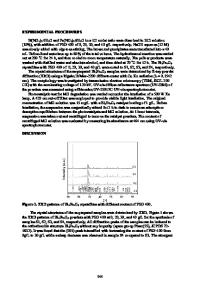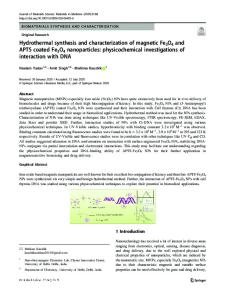Hydrothermal Synthesis of Undoped and Mn-Doped ZnGa 2 O 4 Powders and Thin Films
- PDF / 1,870,320 Bytes
- 11 Pages / 612 x 792 pts (letter) Page_size
- 9 Downloads / 418 Views
Undoped and manganese-doped zinc gallate powders and thin films have been synthesized via the hydrothermal route from aqueous solutions at a pH between 9.5 and 12.5. The chemical composition and the crystal size of the synthesized powder have been studied as a function of pH, temperature, and the composition of the precursor solution, such as the type of hydroxide used and the zinc, gallium, and lithium content. Specimens have been analyzed by x-ray diffraction, scanning and transmission electron microscopy, energy-dispersive x-ray spectroscopy, thermogravimetry, and inductively coupled plasma atomic emission spectroscopy. It is shown that crystallite size and chemical composition strongly depend on the solubility of the gallium species within the solution, which appears to determine the number of ZnGa2O4 nuclei per unit volume. Crystals of a few micrometers in size can be synthesized from solutions where Ga is very soluble (e.g., pH 艌 11), whereas when Ga is not very soluble, the synthesis product is nanocrystalline. Thermogravimetric studies indicate that a considerable amount of OH− is incorporated at the oxygen sites (every 5th to 10th site). Hydrothermal growth of heteroepitaxial zinc gallate thin films has been carried out on (111) MgAl2O4 and (00.1) LiNbO3 substrates. Heteroepitaxy is based on a coincident pattern of oxygen sites in the two structures; that is, (111)ZGO || (111)MAO and (111)ZGO || (00.6)LNO for the out-of plane orientation and (11¯0)ZGO || (11¯0)MAO and (11¯0)ZGO || (11¯0)LNO for the in-plane orientation, respectively. The thin films cover the substrate completely and consist of oriented grains of up to several hundred nanometers in size. In general, the films are twinned with two variants (in separate grains) that are related by a 60° rotation around [111]. This twinning can only be suppressed at high pH and high temperature and only on the MgAl2O4 substrates.
I. INTRODUCTION
Zinc gallate, ZnGa2O4, is one of the new transparent and wide band gap (4.4 eV) semiconducting oxides with the spinel structure. Over the past decade, it has attracted increasing interest as a low-voltage phosphor for vacuum, flat cathode-ray tubes used in field emission displays. When undoped, it provides high-quality, blueband emission, whereas Mn or Cr doping shifts the emission spectra to higher wavelengths and provides tunability over the whole visible spectra. Therefore, zinc gallate might be an excellent material for multicolor emitting thin-film electroluminescent devices. Single-phase zinc gallate has usually been synthesized via either solid-state, reactive firing of oxide powders1–4 or the flux method that uses either lithium phosphate or lead/boron oxide mixtures to create the melt. However, these processes require cost-intensive, long-time heating above 1000 °C. Additionally, Zn volatilization causes serious problems at these temperatures. In another 902
http://journals.cambridge.org
J. Mater. Res., Vol. 19, No. 3, Mar 2004 Downloaded: 16 Mar 2015
approach, mixed oxalate precursors have been prepared
Data Loading...











